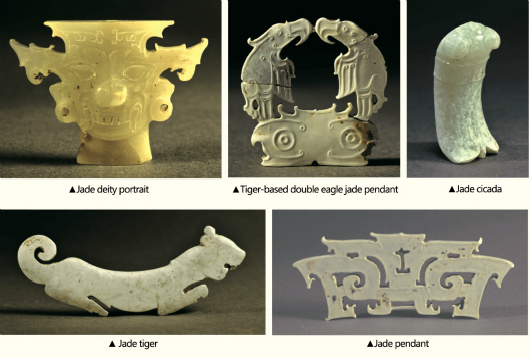
. > TOP STORIES
Forum probes ties between water, civilization
Author : Li Yu and Zha Jianguo Source : Chinese Social Sciences Today 2017-12-15

The picture shows jade artifacts unearthed from the Shijiahe site in Tianmen City, Hubei Province. Shijiahe, measuring an area of eight square kilometers, is the largest, most well-preserved, and, chronologically, the longest-spanning prehistoric settlement excavated to date in the Middle Yangtze River Valley. The archaeological project on the site won the Field Discovery Award at the recent Shanghai Archaeology Forum.
More than 200 scholars and experts from universities and academic institutions around the world recently gathered in Shanghai to discuss the relationship between water resources management and the evolution of ancient civilizations.
The third Shanghai Archaeology Forum (SAF) was held from Dec. 8 to 11 under the theme “Water, Society and Civilization.”
Noting the dialectical, complicated relationship between water and the rise and fall of ancient civilizations, Chinese Academy of Social Sciences (CASS) President Wang Weiguang stressed the significance of investigating how ancient civilizations progressed through different forms of water resources management and utilization because water is a basic natural resource needed to sustain the earth’s ecosystem and support the economic development of human society.
Urbanization, population growth, economic development, political conflicts, and human-induced climate change all contribute to the ever-increasing pressure on the planet’s water resources. Archaeological research on water, waterscapes, water management, sustainable agricultural strategies, and the ritual use and religious importance of water has grown tremendously in recent decades.
Ofer Bar-Yosef, a professor of anthropology at Harvard University, examined the use of water in arid southwestern Asia from Neolithic wells to historical water systems.
The region was vulnerable to minor and a few major climatic fluctuations that impacted early sedentary communities, Bar-Yosef said, adding that appearance of wells in the early Neolithic age and the use of water channels were among the earliest reactions to the natural reduction of winter rains.
Digging wells during the Chalcolithic period and the development of water systems during the Bronze and Iron ages were among the techniques developed to cope with water shortages for humans and animals, and it was particularly vital during times of social conflicts and wars, Bar-Yosef said.
Later a large number of underground tunnels were constructed, assisted by a series of dug-up wells, originating in underground springs, channeling water for irrigation along distances of many kilometers, Bar-Yosef said.
Adequate water supplies for drinking and irrigation remain a critical problem for the survival of humans and animals in semi-arid regions, such as Southwestern Asia, he said.
Zhang Jianfeng, a research fellow from the Institute of Archaeology at CASS, shed light on the Han Chang’an City, the capital city of the Western Han and Xin dynasties. Throughout the 200 years in Chang’an, water infrastructure of different forms and functions was erected in the urban and rural sections of the city.
“The systematic and diverse blueprint of the water system promoted the waterworks of and prevented floods in Chang’an, providing a solid bedrock for the survival and development of the city,” Zhang said.
The water infrastructure at Chang’an can be divided into four different functional systems: water storage, sewage drainage, urban water landscaping and water transportation, Zhang said. The facilities of these systems were distributed in different sections of the urban and rural regions of Chang’an, thus guaranteeing water usage, drainage, and transportation in the entire city.
One of the major parts of the forum was presenting the SAF Awards to those individuals and organizations that have achieved distinction by making major discoveries and producing innovative, creative, and rigorous works in the past two years.
The Lifetime Achievement Award went to Brian Fagan, a professor from the University of California, Santa Barbara. Chris Scarre, a professor at the University of Durham in Britain and Maamoun Abdulkarim, a professor from Damascus University in Syria, won the Distinguished Service Awards.
The forum also issued 10 Field Discovery Awards and nine Research Awards. The Chinese project “New Discoveries at Shijiahe—A Central Prehistoric Settlement in the Middle Yangtze Region” got the Field Discovery Award, and the “Taosi: The Beginning of ‘China’ and ‘Central Plain’” project was conferred the Research Award.
Public participation can transform archeology from a discipline focused on the past into a vigorous social force, making human thought and culture more continuous and creative. The forum invited Chinese and foreign archeologiststo give nine public archeology lectures from Dec. 6 to 11, introducing world-famous archaeological discoveries and achievements to raise public awareness of their significance.
Founded in 2013, the biennial SAF was co-sponsored by CASS and Shanghai Municipal People’s Government, and organized by the Institute of Archaeology at CASS, Shanghai Municipal Bureau of Cultural Heritage, Shanghai Academy, and Shanghai University.
Ye Shengtao made Chinese fairy tales from a wilderness
Ye Shengtao (1894–1988) created the first collection of fairy tales in the history of Chinese children’s literature...
-
How northern ethnicities integrated into Chinese nation
2023-09-18
-
Mogao caves
2023-09-12
-
Mogao Grottoes as ‘a place of pilgrimage’
2023-09-12
-
Time-honored architectural traditions in China
2023-08-29
-
Disentangling the civilizational evolution of China
2023-08-28
-
AI ethics in science fiction
2023-08-23













 2011-2013 by www.cssn.cn. All Rights Reserved
2011-2013 by www.cssn.cn. All Rights Reserved